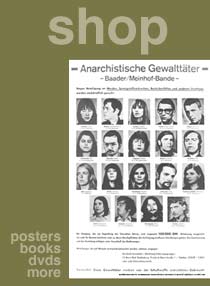pre-1968 > 1968 > 1969 > 1970 > 1971 > 1972 > 1973 > 1974 > 1975 > 1976 > 1977 > post-1977
.jpg) |
1975, Stuttgart - Ostracized by her terrorist comrades, Ulrike Marie Meinhof grows depressed in Stammheim Prison.
|
1975
1 January, Bonn
"Lex Baader-Meinhof," or the "Baader-Meinhof Laws" become effective. These laws, which are amendments to the "Basic Law," West Germany's quasi-constitution, allow the courts to exclude a lawyer from defending a client merely if there is suspicion of the lawyer "forming a criminal association with the defendant." The new laws also allow for trials to continue in the absence of a defendant if the reason for the defendant's absence is of the defendant's own doing; i.e. they are ill from a hunger strike.
27 February, Berlin
At about 9:00 AM, Peter Lorenz leaves his home in the Zehlendorf district. Lorenz is the CDU (Christian Democrat Union) candidate for mayor in the West Berlin city elections to be held in three days. Less than half a mile from his house, his Mercedes is blocked by a large truck, and a Fiat rams his car. Lorenz's driver, Werner Sowa, is beaten, and Lorenz is kidnapped into a waiting automobile. The kidnappers are from Movement 2 June. Sowa identifies Angela Luther, who has been underground for three years, as one of the kidnappers.
Authorities put up a $44,000 reward for information. Current Berlin Mayor Klaus Schütz (Lorenz's SPD opponent and a personal friend of Lorenz's) announces that the elections will take place as scheduled, but all campaigning will be called off.
28 February, Berlin
A Polaroid photo is released early in the morning showing Lorenz with a sign around his neck: "Peter Lorenz, prisoner of the 2 June Movement." With the photo is a demand for the immediate release of six terrorists: Horst Mahler, Verena Becker, Gabriele Kröcher-Tiedemann, Ingrid Siepmann, Rolf Heissler, and Rolf Pohle. Except for Mahler, all are either members of Movement 2 June, or connected to it. A message is attached to the demands: "to our [Baader-Meinhof] comrades in jail. We would like to get more of you out, but at our present strength we're not in a position to do it." The kidnappers have been careful in making their selections; no terrorist accused of murder is on the list.
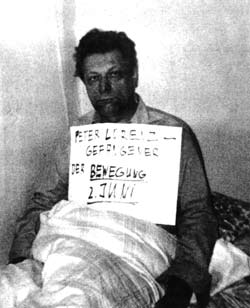 |
28 February 1975, Berlin - "Peter Lorenz, captive of Movement 2 June" reads the Polaroid photo sent to police the day after the capture of Lorenz, the CDU Berlin mayoral candidate.
|
The kidnappers demand that authorities provide a Boeing 707 within three days. Three of the prisoners, Pohle, Kröcher-Tiedemann, and Heissler, must be flown from their jails throughout the Federal Republic to Berlin within two days. The others are already in Berlin. When all six are ready to fly on the 707 to a country of their choice, they are to be given $9,000 each. Furthermore, the kidnappers want former Mayor Heinrich Albertz to accompany their jailed comrades on the flight to guarantee their passage. Albertz was the mayor who initially condemned the rioting during the Shah visit on 2 June, 1967, but was ousted after he had a change of heart. Albertz agrees to participate, but only in his role as a Protestant pastor, and not in his role as a former politician.
The kidnappers also demand the unconditional release from a Berlin prison of a couple of small-time left-wing protestors, Ettore Canella, an Italian, and Gerhard Jagdmann, who both were arrested for protesting during the previous November.
1 March, Berlin
Newspapers worldwide print the image of Ettore Canella sprinting to freedom out of his Berlin jail. Behind him, Gerhard Jagdmann strolls out assuredly.
During their evening broadcasts, the German news programs show interviews with Gabi Kröcher-Tiedemann from her Essen jail cell, and Horst Mahler from his Berlin cell; both refuse to be released, electing to stay in prison.
1-3 March, Stuttgart
Bugs are secretly installed in five of the Baader-Meinhof cells at Stammheim prison, by the Counter-Espionage unit of the Office for the Protection of the Constitution.
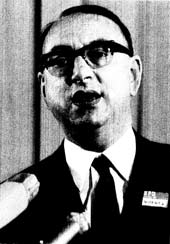 |
28 February, Berlin - Heinrich Albertz, former mayor of Berlin during the 2 June 1972 protest, agrees to accompany released terrorists to their freedom in the middle east in exchange for the release of kidnapped mayor candidate Peter Lorenz.
|
4 March, Frankfurt & Berlin
Heinrich Albertz and the rest of the Lufthansa crew fly back to Frankfurt from Aden, South Yemen, having released Pohle, Becker, Heissler, Siepmann, and Kröcher-Tiedemann (who had a second change of heart and elected to make the trip after all).
A car screams through Berlin's Wilmersdorf district shortly before midnight. Lorenz is pushed out of the back seat, his blindfold removed, and given a 50-fenning coin. He stumbles over to a phone booth as the car tears off. Lorenz calls his wife and lets her know that the ordeal is over. Within minutes police begin raiding suspected radical hideouts throughout Berlin and the Federal Republic.
6 March, Paris
A bomb rips through the Paris offices of Axel Springer's newspaper chain, destroying it. A Paris news agency receives a typewritten note from "the 6 March group," claiming that the bombing was committed to demand "the liberation and total amnesty of the Baader-Meinhof group."
8 March, Aden
Press reports indicate that leftist South Yemen government has asked the freed terrorists to leave their country, apparently from pressure by West Germany.
15 April, Karlsruhe
Four American lawyers formally protest the "Baader-Meinhof Laws" in Germany's Constitutional Court: former US Attorney General Ramsey Clark, radical "Chicago Seven" lawyer William Kunstler, powerful leftist lawyer Peter Weiss, and William Schaap.
Their protests do little good. The court approves the laws, allowing the Baader-Meinhof judges to exclude Klaus Croissant, Kurt Groenwald, and Hans-Christian Ströbele from the defense team. These moves are ironic because Croissant, Groenwald, and Ströbele have all been recently kicked off of the defense team already by the Baader. The Baader-Meinhof defendants clearly want it known who was in control, and any perceived ideological weakening of one of their lawyers resulted in the sacking of that lawyer.
24 April, Stockholm
Six Red Army Faction terrorists, most of whom were former members of the Heidelberg Socialist Patients Collective (SPK), take over the West German Embassy in Stockholm, taking 11 hostages. The terrorists are: Siegfried Hauser, Hanne-Elise Krabbe, Karl-Heinz Dellwo, Lutz Taufer, Bernhard-Maria Rössner, and Ullrich Wessel. Swedish police quickly occupy the lower portion of the embassy. The terrorists order them to leave, saying they will kill the military attaché if the police don't comply. They don't. Angry, the terrorist bind the hands of the embassy's military attaché, Lieutenant Colonel Baron Andreas von Mirchbach, and order him to walk toward the top of the stairs of the upper floor. Then they shoot him in the leg, head and chest. Police drag the dying man away (after stripping down to their underwear to show that they were unarmed) and then move out of the building.
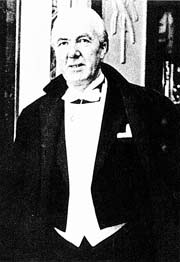 |
24 April, Stockholm - Dr. Heinz Hillegart, the West German embassy's economic attaché is killed during a takeover of the embassy by SPK members who were now aligned with the Red Army Faction.
|
The terrorists pile massive amounts of TNT into the basement of the facility, and then call the German Press Agency and list their demands. The want all Baader-Meinhof defendants released immediately. This time Bonn does not respond quite as favorably as they did during the Lorenz kidnapping. The kidnappers indicate that they will begin shooting a hostage every hour until their demands are met. After one hour Dr. Heinz Hillegart, the embassy's economic attaché is taken to an open window. A terrorist shoots him and leaves the elderly Hillegart's body hanging like a rag doll out of the window.
Shortly before midnight a wiring short causes the TNT to explode prematurely. Ullrich Wessel is killed immediately, but all of the other terrorists and hostages survive, most with bad burns. All of the terrorists are captured without a fight. Terrorist Siegfried Hausner is particularly badly burned, and is flown to Stammheim Prison's medical ward a few days later. He dies in prison on 5 May.
The terrorists in the operation had been handpicked by Siegfried Haag, the lawyer associate of Klaus Croissant. With the imprisonment of the leaders of the Baader-Meinhof Gang, Haag has become the de facto leader of the so-called "second generation of the RAF," which is dedicated almost solely to freeing the first generation's leaders from prison.
Mid-May, Stuttgart
Technicians from the Federal Intelligence Service install two more bugs in two unoccupied Stammheim cells; now seven Baader-Meinhof prison ward cells are bugged.
21 May, Stuttgart
The pretrial hearings of the Baader-Meinhof leaders begins in the newly constructed Stammheim prison courtroom. Utilitarian in nature, the courtroom was constructed on the grounds of Stammheim prison at a cost of DM 15,000,000. The roof is covered with jagged razor wire to prevent helicopter landings and steel nets to prevent any potential airborne bombs from doing damage, the entrance has a sophisticated metal detector.
Otto Schily, Marielouise Becker, Rupert von Plottnitz, and Helmut Riedel are present as defense lawyers, but Baader is still without representation with the expulsion of Croissant, Ströbele and Groenwald. Several state appointed defense lawyers are present as well. Judge Theodor Prinzing is the lead judge of several judges that jointly oversee the trial.
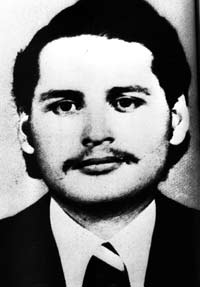 |
21 December, Vienna - "Carlos the Jackal" takes over an OPEC conference along with members of the Revolutionary Cells and Movement 2 June. Carlos secures 5 million dollars in ranson for Palestinian causes.
|
5 June, Stuttgart
Baader begins the second day of hearings by reminding the court that is still without representation. He also makes the bold claim that the cells are bugged. His suspicions are dismissed out of hand by the skeptical German press; Baader is getting paranoid, they say.
Two years later the existence of the bugs will be admitted by government authorities. They will claim that they only monitored the bugs briefly during the Stockholm Embassy stand-off, and again briefly in 1976. Supposedly the authorities immediately erased all of the tapes; no copies will ever turn up.
23 June, Stuttgart
Croissant and Ströbele are arrested and Croissant's Stuttgart offices are raided.
19 August, Stuttgart
The defendants are finally officially charged: Gudrun Ensslin, Andreas Baader, Ulrike Meinhof, and Jan-Carl Raspe are jointly charged with four murders, 54 attempted murders and a single count of forming a criminal association.
Mid-Summer, Berlin
Members of the Movement 2 June steal thousands of U-Banh (subway) tickets and freely distribute them to grateful Berliners upset at recent price hikes in the tickets. Movement 2 June members also participate in two bank raids in which they distribute chocolate kisses to the customers and bank staff.
By September, however, most of the Movement 2 June leadership is in jail: Ralf Reinders, Till Meyer, Inge Viett, Julianne Plambeck, Fritz Teufel, and Gabrielle Rollnick. They are all charged with the Lorenz kidnapping and the bank raids. Reinders is charged with the murder of von Drenkmann in November of the previous year.
21 December, Vienna
An all-star cast of terrorists, led by the infamous Carlos the Jackal, bursts into a OPEC conference. Among the terrorists were Gabriele Kröcher-Tiedemann, the Movement 2 June member who had been released as part of the Lorenz kidnapping, and Hans-Joachim Klein, a member of the little-known German terrorist group Revolutionary Cells, who had served as Jean-Paul Sartre's chauffeur when he visited Baader in Stammheim. Kröcher-Tiedemann kills two men in the raid, an Austrian policeman Anton Tichler, and an Iraqi guard, Khafali. Carlos kills a Libyan civil servant, Yousef Ismirli. Klein is seriously wounded in the mêlée, but the operation otherwise works out well; Carlos secures $5 million ransom for Palestinian causes and the terrorists are able to disappear into the Middle East.

